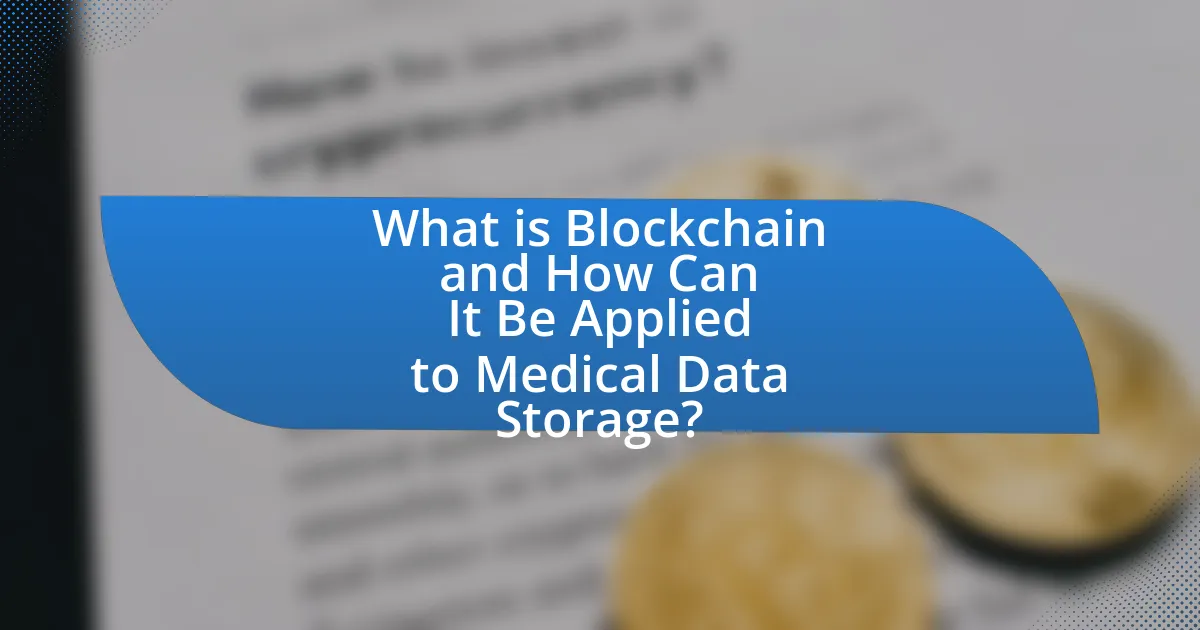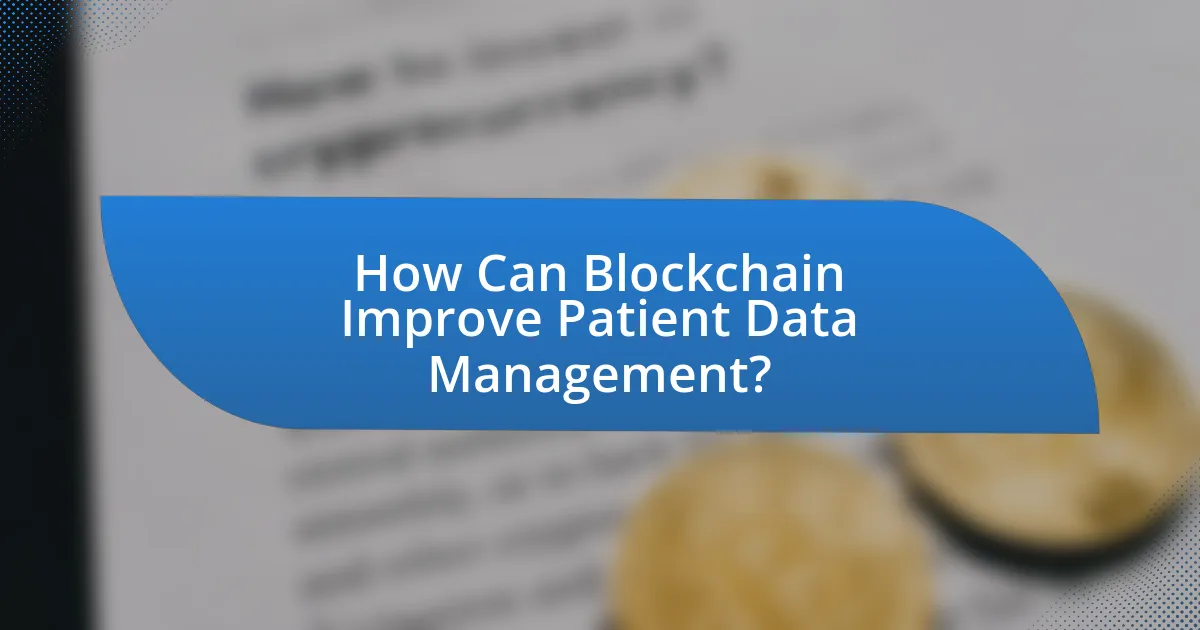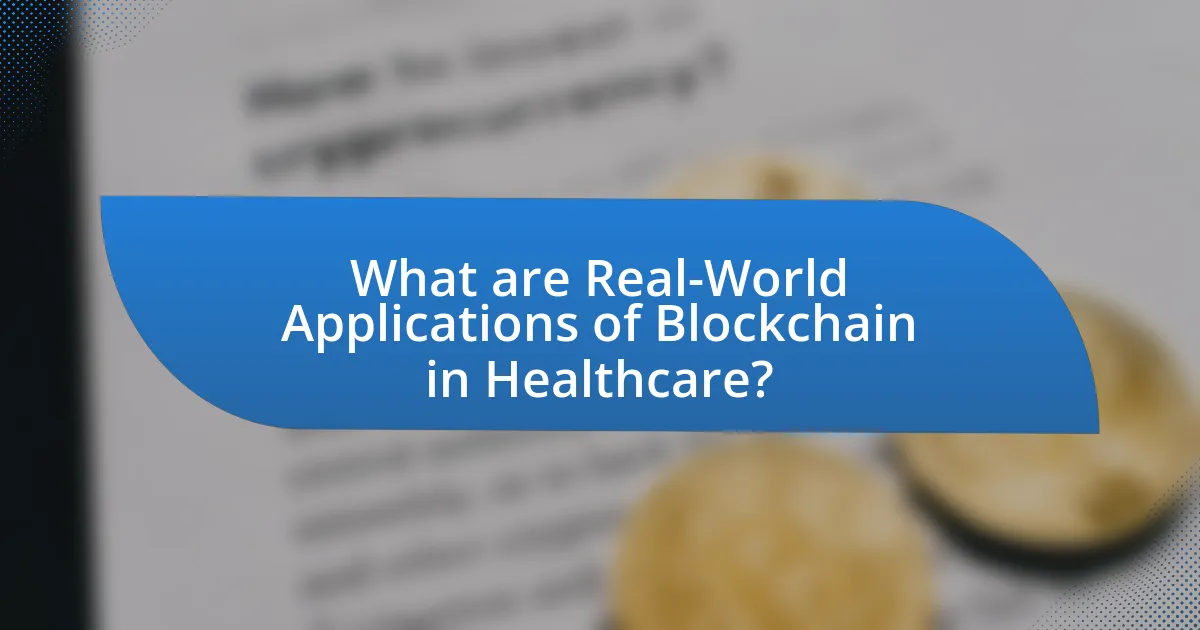Blockchain is a decentralized digital ledger technology that offers significant advantages for medical data storage, including enhanced security, interoperability, and patient privacy. This article explores how blockchain functions, its key components, and its unique features that benefit healthcare systems. It addresses the challenges of scalability, regulatory compliance, and interoperability that hinder blockchain adoption in healthcare, while also highlighting real-world applications and successful case studies. Additionally, the article discusses future trends, the potential role of artificial intelligence, and practical steps healthcare organizations can take to implement blockchain solutions effectively.

What is Blockchain and How Can It Be Applied to Medical Data Storage?
Blockchain is a decentralized digital ledger technology that securely records transactions across multiple computers, ensuring that the data cannot be altered retroactively without the consensus of the network. In the context of medical data storage, blockchain can enhance data security, interoperability, and patient privacy by allowing healthcare providers to share patient records in a secure and transparent manner. For instance, a study published in the Journal of Medical Internet Research highlights that blockchain can facilitate secure sharing of electronic health records (EHRs) while maintaining patient consent and data integrity. This application of blockchain not only protects sensitive medical information from unauthorized access but also streamlines data management processes in healthcare systems.
How does blockchain technology function in general?
Blockchain technology functions as a decentralized digital ledger that records transactions across multiple computers in a way that ensures the recorded data cannot be altered retroactively. Each transaction is grouped into a block, which is then linked to the previous block, forming a chain. This structure is secured through cryptographic hashing, which provides integrity and authenticity to the data. The decentralized nature of blockchain means that no single entity has control over the entire chain, making it resistant to fraud and tampering. Additionally, consensus mechanisms, such as Proof of Work or Proof of Stake, validate transactions, ensuring that all participants agree on the state of the ledger. This functionality is particularly relevant in medical data storage, where secure, immutable records are crucial for patient privacy and data integrity.
What are the key components of blockchain technology?
The key components of blockchain technology are decentralization, immutability, transparency, and security. Decentralization ensures that no single entity controls the entire network, allowing for distributed consensus among participants. Immutability refers to the inability to alter or delete data once it has been recorded on the blockchain, which enhances trust in the system. Transparency allows all participants to view the transaction history, fostering accountability. Security is achieved through cryptographic techniques that protect data from unauthorized access and tampering. These components collectively enable blockchain to function effectively, particularly in applications like medical data storage, where data integrity and security are paramount.
How does decentralization enhance data security in blockchain?
Decentralization enhances data security in blockchain by distributing data across multiple nodes, reducing the risk of a single point of failure. In a decentralized network, each participant maintains a copy of the entire blockchain, making it difficult for malicious actors to alter or corrupt data without consensus from the majority of nodes. This consensus mechanism, often achieved through protocols like Proof of Work or Proof of Stake, ensures that any changes to the data require validation from multiple sources, thereby increasing the integrity and security of the information stored. Additionally, the use of cryptographic techniques in blockchain further protects data from unauthorized access and tampering, reinforcing the overall security framework.
What are the unique features of blockchain that benefit medical data storage?
Blockchain offers unique features that significantly benefit medical data storage, including decentralization, immutability, and enhanced security. Decentralization allows medical data to be stored across a distributed network, reducing the risk of single points of failure and enhancing data availability. Immutability ensures that once data is recorded on the blockchain, it cannot be altered or deleted, which is crucial for maintaining accurate and trustworthy medical records. Enhanced security is achieved through cryptographic techniques that protect sensitive patient information from unauthorized access and breaches. These features collectively contribute to a more reliable, transparent, and efficient system for managing medical data, as evidenced by studies showing that blockchain can improve data integrity and patient privacy in healthcare settings.
How does immutability contribute to data integrity in healthcare?
Immutability enhances data integrity in healthcare by ensuring that once data is recorded, it cannot be altered or deleted. This characteristic is crucial in maintaining accurate patient records, as it prevents unauthorized modifications and ensures that the historical accuracy of medical data is preserved. For instance, blockchain technology, which is inherently immutable, allows healthcare providers to securely store patient information, ensuring that any changes are transparently recorded and traceable. This transparency is vital for compliance with regulations such as HIPAA, which mandates the protection of patient data integrity. By utilizing immutable systems, healthcare organizations can significantly reduce the risk of data tampering and fraud, thereby fostering trust among patients and stakeholders.
What role does transparency play in patient data management?
Transparency in patient data management is crucial for ensuring trust and accountability among stakeholders. It allows patients to understand how their data is collected, stored, and used, which is essential for informed consent. Furthermore, transparency facilitates compliance with regulations such as HIPAA, which mandates clear communication regarding data handling practices. Studies have shown that organizations that prioritize transparency in data management experience higher patient satisfaction and engagement, as patients feel more secure knowing their information is being handled responsibly.
What challenges does blockchain face in the context of medical data storage?
Blockchain faces several challenges in the context of medical data storage, primarily related to scalability, interoperability, and regulatory compliance. Scalability issues arise because blockchain networks can struggle to handle the high volume of transactions required for extensive medical data, leading to slower processing times. Interoperability challenges occur as different healthcare systems and blockchain platforms may not communicate effectively, hindering data sharing and integration. Additionally, regulatory compliance is a significant concern, as healthcare data is subject to strict privacy laws, such as HIPAA in the United States, which can complicate the implementation of blockchain solutions. These challenges must be addressed to fully realize the potential of blockchain in medical data storage.
How do regulatory concerns impact the adoption of blockchain in healthcare?
Regulatory concerns significantly hinder the adoption of blockchain in healthcare by creating barriers to compliance with existing laws and standards. Healthcare organizations must navigate complex regulations such as HIPAA in the United States, which mandates strict data privacy and security measures. These regulations often require that patient data remains confidential and is stored in a manner that allows for auditability and accountability, which can conflict with the decentralized nature of blockchain technology. Furthermore, the lack of clear regulatory frameworks specifically addressing blockchain applications in healthcare leads to uncertainty, discouraging investment and innovation in this area. For instance, a study by Deloitte in 2020 highlighted that 39% of healthcare executives cited regulatory uncertainty as a major barrier to blockchain adoption.
What are the technical limitations of implementing blockchain in medical systems?
The technical limitations of implementing blockchain in medical systems include scalability issues, interoperability challenges, and data privacy concerns. Scalability is a significant limitation as blockchain networks often struggle to handle the high volume of transactions required in medical systems, leading to slower processing times. For instance, Bitcoin can process approximately seven transactions per second, while medical systems may require thousands of transactions per second to function effectively.
Interoperability challenges arise because different blockchain platforms may not communicate with each other, complicating data sharing across various healthcare providers and systems. This lack of standardization can hinder the seamless exchange of medical records, which is crucial for patient care.
Data privacy concerns are also prominent, as blockchain’s transparency can conflict with regulations like HIPAA, which mandates strict confidentiality for patient information. While blockchain can enhance security through cryptographic techniques, the immutable nature of the technology means that once data is recorded, it cannot be altered or deleted, raising concerns about the handling of sensitive medical information.

How Can Blockchain Improve Patient Data Management?
Blockchain can improve patient data management by providing a secure, decentralized platform for storing and sharing medical records. This technology enhances data integrity and security through cryptographic techniques, ensuring that patient information is tamper-proof and accessible only to authorized parties. According to a study published in the Journal of Medical Internet Research, blockchain can reduce data breaches by 50% due to its decentralized nature, which eliminates single points of failure. Additionally, blockchain facilitates interoperability among healthcare systems, allowing seamless data exchange while maintaining patient privacy, as evidenced by the findings of the Healthcare Information and Management Systems Society.
What are the potential benefits of using blockchain for electronic health records (EHR)?
The potential benefits of using blockchain for electronic health records (EHR) include enhanced security, improved interoperability, and increased patient control over their data. Blockchain technology provides a decentralized and immutable ledger, which significantly reduces the risk of data breaches and unauthorized access, as evidenced by the fact that healthcare data breaches affected over 45 million individuals in 2020 alone. Additionally, blockchain facilitates seamless data sharing among healthcare providers, improving interoperability and ensuring that patient information is readily accessible across different systems. This is crucial, as studies show that better data sharing can lead to improved patient outcomes. Furthermore, blockchain empowers patients by allowing them to control access to their health records, fostering trust and engagement in their healthcare journey.
How can blockchain enhance patient consent management?
Blockchain can enhance patient consent management by providing a secure, transparent, and immutable record of consent transactions. This technology allows patients to grant, revoke, or modify their consent for data sharing in real-time, ensuring that their preferences are accurately reflected and easily accessible. The decentralized nature of blockchain eliminates the risk of unauthorized access or tampering, as each transaction is recorded across multiple nodes, making it nearly impossible to alter without consensus. Furthermore, studies indicate that blockchain can streamline the consent process, reducing administrative burdens and improving compliance with regulations such as HIPAA.
What impact does blockchain have on interoperability among healthcare systems?
Blockchain significantly enhances interoperability among healthcare systems by providing a decentralized and secure framework for data exchange. This technology enables different healthcare entities to access and share patient data seamlessly while maintaining data integrity and security. For instance, a study published in the Journal of Medical Internet Research highlights that blockchain can facilitate real-time access to patient records across various platforms, reducing data silos and improving care coordination. By utilizing smart contracts, blockchain ensures that data sharing adheres to regulatory compliance and patient consent, further promoting interoperability.
How does blockchain facilitate secure data sharing among healthcare providers?
Blockchain facilitates secure data sharing among healthcare providers by creating a decentralized and immutable ledger that ensures data integrity and confidentiality. Each transaction or data entry is encrypted and linked to previous entries, making unauthorized alterations nearly impossible. This technology allows healthcare providers to share patient records in real-time while maintaining strict access controls, ensuring that only authorized personnel can view sensitive information. Furthermore, studies indicate that blockchain can reduce data breaches by up to 80%, highlighting its effectiveness in enhancing security in healthcare data sharing.
What mechanisms ensure data privacy while using blockchain?
Blockchain employs several mechanisms to ensure data privacy, including encryption, access control, and data anonymization. Encryption secures data by converting it into a coded format that can only be accessed by authorized users with the correct decryption keys. Access control mechanisms restrict data visibility and interactions based on user permissions, ensuring that only designated individuals can view or modify sensitive information. Data anonymization techniques further enhance privacy by removing personally identifiable information, making it difficult to trace data back to individual patients. These mechanisms collectively protect sensitive medical data stored on blockchain networks, ensuring compliance with regulations such as HIPAA and GDPR.
How can blockchain reduce fraud in medical billing and claims?
Blockchain can reduce fraud in medical billing and claims by providing a secure, transparent, and immutable ledger for all transactions. This technology enables real-time tracking of claims and billing processes, ensuring that all parties involved have access to the same verified information. For instance, a study published in the Journal of Medical Internet Research highlights that blockchain can enhance data integrity and reduce discrepancies in billing by allowing healthcare providers to record services rendered directly onto the blockchain, which can then be cross-verified by insurers. This reduces the likelihood of fraudulent claims, as any attempt to alter the data would be easily detectable due to the decentralized nature of blockchain technology.

What are Real-World Applications of Blockchain in Healthcare?
Real-world applications of blockchain in healthcare include secure patient data management, drug traceability, and clinical trial management. Blockchain technology enables healthcare providers to store patient records in a decentralized manner, ensuring data integrity and security while allowing patients to control access to their information. For instance, the MediLedger Project demonstrates how blockchain can enhance drug supply chain transparency by tracking pharmaceuticals from manufacturers to pharmacies, reducing counterfeit drugs. Additionally, blockchain facilitates the management of clinical trials by providing a tamper-proof record of trial data, which can improve trust and compliance among stakeholders. These applications illustrate the transformative potential of blockchain in enhancing efficiency and security in healthcare systems.
What successful case studies exist for blockchain in medical data storage?
Successful case studies for blockchain in medical data storage include the MedRec project by MIT, which utilizes blockchain to manage electronic medical records while ensuring patient privacy and data integrity. Another notable example is the Medicalchain platform, which allows patients to control their medical data and share it securely with healthcare providers. Additionally, the Guardtime initiative in Estonia has implemented blockchain technology to secure health records, enhancing data accessibility and security for patients and healthcare professionals. These case studies demonstrate the effectiveness of blockchain in improving the security, interoperability, and management of medical data.
How have hospitals implemented blockchain for patient data management?
Hospitals have implemented blockchain for patient data management by creating decentralized and secure systems that enhance data integrity and accessibility. For instance, the use of blockchain allows hospitals to store patient records in a tamper-proof manner, ensuring that any changes to the data are recorded transparently and can be traced back to their origin. A notable example is the collaboration between the Mayo Clinic and other healthcare organizations to develop a blockchain-based platform that facilitates secure sharing of patient data while maintaining privacy and compliance with regulations like HIPAA. This implementation not only improves the accuracy of patient records but also streamlines processes such as patient consent and data sharing among providers, ultimately leading to better patient outcomes.
What lessons can be learned from early adopters of blockchain in healthcare?
Early adopters of blockchain in healthcare demonstrate the importance of interoperability and data security. These organizations have shown that implementing blockchain can enhance patient data sharing while maintaining privacy and compliance with regulations such as HIPAA. For instance, the use of blockchain by companies like Chronicled has improved supply chain transparency and reduced fraud in pharmaceutical distribution. Additionally, early adopters highlight the necessity of stakeholder collaboration, as seen in initiatives like MedRec, which involves partnerships among healthcare providers, patients, and technology developers to create a unified patient record system. These lessons underscore the potential of blockchain to transform healthcare data management by ensuring secure, efficient, and collaborative practices.
How can blockchain technology be integrated with existing healthcare systems?
Blockchain technology can be integrated with existing healthcare systems by creating a decentralized and secure framework for managing patient data. This integration can enhance data interoperability, allowing different healthcare providers to access and share patient information seamlessly while maintaining data integrity and security. For instance, using blockchain can enable real-time updates to patient records, ensuring that all stakeholders have access to the most current information, which is crucial for effective treatment. Additionally, studies have shown that blockchain can reduce administrative costs and improve patient consent management by providing a transparent and tamper-proof record of patient permissions. This approach not only streamlines operations but also builds trust among patients and providers, as evidenced by pilot projects in various healthcare settings demonstrating improved data accuracy and reduced fraud.
What are the best practices for implementing blockchain in healthcare settings?
The best practices for implementing blockchain in healthcare settings include ensuring data interoperability, maintaining patient privacy, and establishing clear governance structures. Data interoperability allows different healthcare systems to communicate effectively, which is crucial for patient care and data sharing. Maintaining patient privacy is essential, as healthcare data is sensitive; utilizing encryption and access controls can help protect this information. Establishing clear governance structures involves defining roles and responsibilities among stakeholders, which is vital for accountability and compliance with regulations such as HIPAA. These practices are supported by studies indicating that effective governance and interoperability can enhance the efficiency and security of healthcare data management.
How can stakeholders collaborate to enhance blockchain adoption in healthcare?
Stakeholders can collaborate to enhance blockchain adoption in healthcare by forming partnerships that focus on shared goals, such as improving data interoperability and patient privacy. For instance, healthcare providers, technology companies, and regulatory bodies can work together to develop standardized protocols that facilitate the integration of blockchain solutions into existing healthcare systems. A study by the World Health Organization highlights that collaborative frameworks can lead to more effective implementation of technology in healthcare, as seen in successful pilot projects that have demonstrated improved data security and patient outcomes. By aligning their interests and resources, stakeholders can create a conducive environment for blockchain technology to thrive in the healthcare sector.
What are the future trends for blockchain in medical data storage?
Future trends for blockchain in medical data storage include enhanced interoperability, improved patient control over data, and increased security through decentralized systems. Interoperability will allow different healthcare systems to share and access medical data seamlessly, facilitating better patient care. Patients will gain more control over their medical records, enabling them to grant or revoke access to healthcare providers as needed. Additionally, the decentralized nature of blockchain will enhance security by reducing the risk of data breaches, as sensitive information will not be stored in a single location. These trends are supported by ongoing research and pilot projects demonstrating blockchain’s potential to transform healthcare data management.
How might advancements in blockchain technology shape healthcare data management?
Advancements in blockchain technology may significantly enhance healthcare data management by providing secure, decentralized, and immutable data storage solutions. Blockchain’s inherent characteristics, such as transparency and traceability, enable healthcare providers to maintain accurate patient records while ensuring data integrity. For instance, a study published in the Journal of Medical Internet Research highlights that blockchain can reduce data breaches by up to 80% due to its encryption and distributed ledger capabilities. This technology allows for seamless sharing of patient information among authorized parties, improving interoperability and reducing administrative burdens. Additionally, smart contracts can automate processes like billing and consent management, further streamlining operations in healthcare settings.
What role will artificial intelligence play in conjunction with blockchain in healthcare?
Artificial intelligence will enhance blockchain in healthcare by improving data analysis, security, and interoperability. AI algorithms can analyze vast amounts of medical data stored on blockchain, enabling predictive analytics for patient outcomes and personalized treatment plans. Additionally, AI can strengthen security measures by identifying anomalies and potential breaches in real-time, ensuring the integrity of sensitive health information. Furthermore, the combination of AI and blockchain facilitates seamless data sharing among healthcare providers, improving care coordination and reducing administrative burdens. This synergy is supported by studies indicating that AI can significantly optimize data management processes, leading to more efficient healthcare delivery.
What practical steps can healthcare organizations take to explore blockchain solutions?
Healthcare organizations can explore blockchain solutions by conducting a feasibility study to assess specific use cases, such as secure patient data sharing and supply chain management. This involves identifying key stakeholders, including IT teams and healthcare providers, to evaluate the potential benefits and challenges of implementing blockchain technology. Additionally, organizations should engage with blockchain experts and technology vendors to understand the available platforms and tools that can be tailored to their needs. Pilot projects can then be initiated to test blockchain applications in controlled environments, allowing organizations to gather data on performance and scalability. Research indicates that 83% of healthcare executives believe blockchain will be critical to their industry, highlighting the importance of proactive exploration in this area.


